LINGUISTICS FOR LANGAUGE TEACHING Name of the University Author Name
VerifiedAdded on 2022/08/17
|9
|3132
|275
AI Summary
Analytic assessment - Pick up a text and make a full analysis. Genre, tenor, mode, etc.
Contribute Materials
Your contribution can guide someone’s learning journey. Share your
documents today.
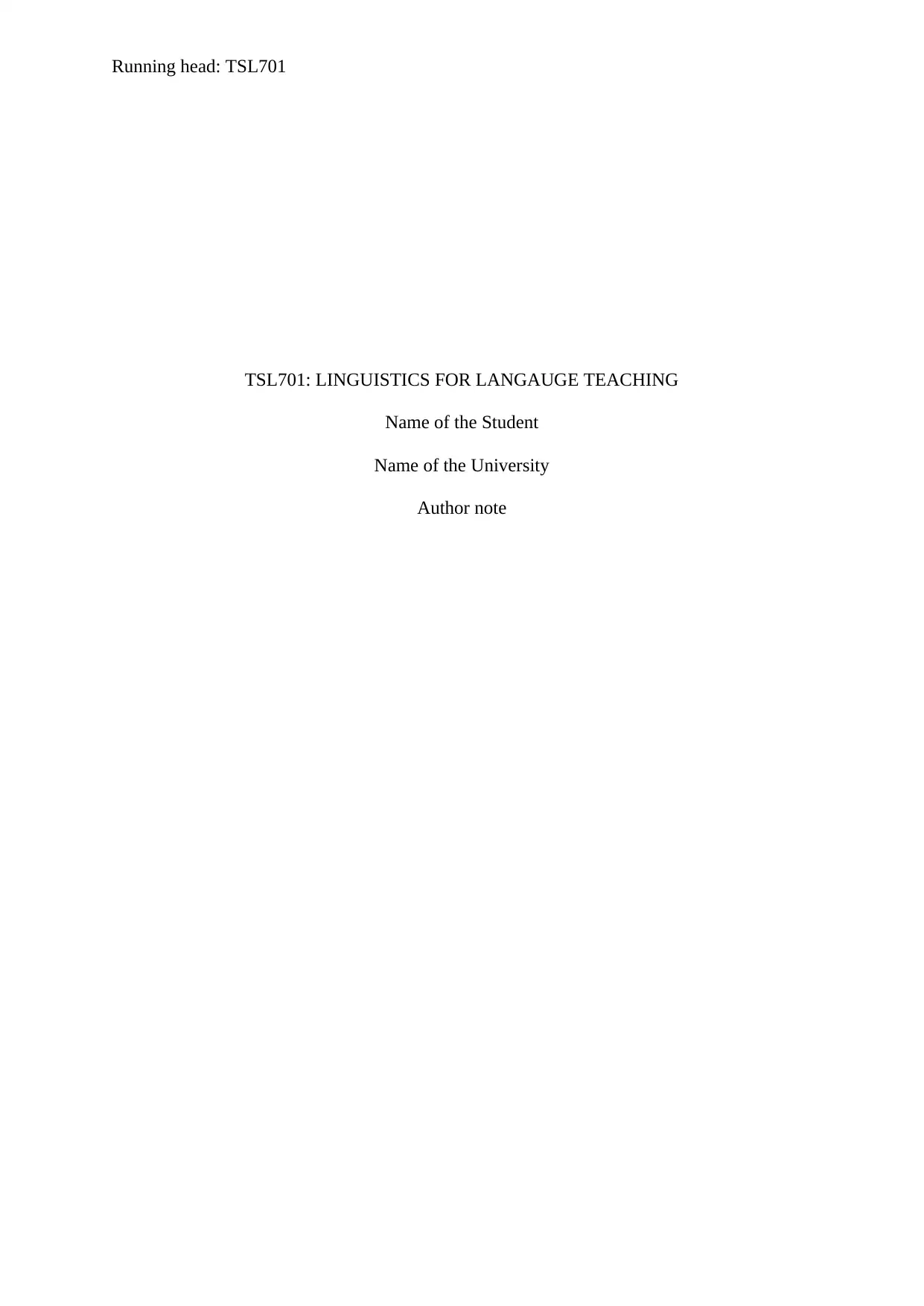
Running head: TSL701
TSL701: LINGUISTICS FOR LANGAUGE TEACHING
Name of the Student
Name of the University
Author note
TSL701: LINGUISTICS FOR LANGAUGE TEACHING
Name of the Student
Name of the University
Author note
Secure Best Marks with AI Grader
Need help grading? Try our AI Grader for instant feedback on your assignments.
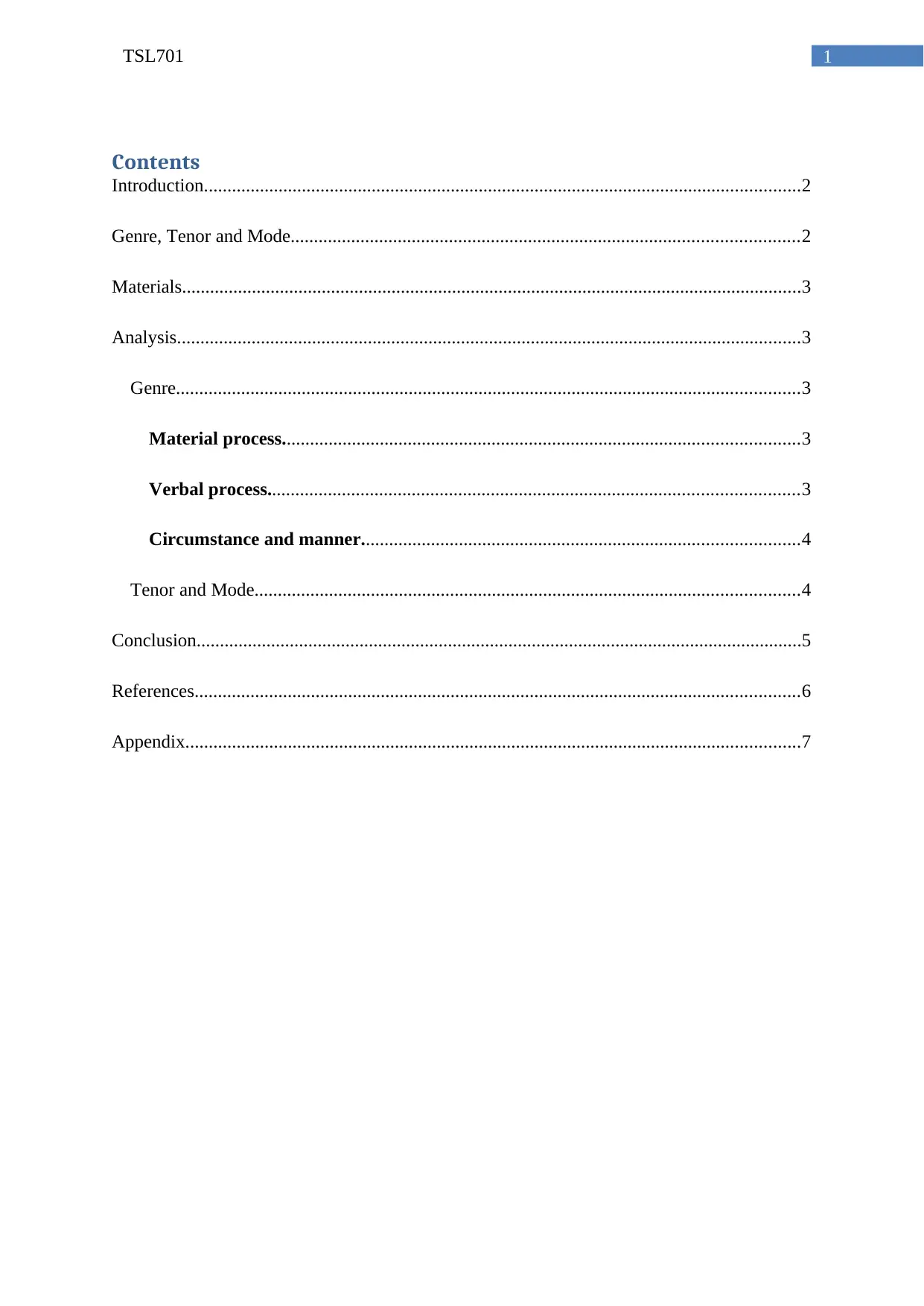
1TSL701
Contents
Introduction................................................................................................................................2
Genre, Tenor and Mode.............................................................................................................2
Materials.....................................................................................................................................3
Analysis......................................................................................................................................3
Genre......................................................................................................................................3
Material process...............................................................................................................3
Verbal process..................................................................................................................3
Circumstance and manner..............................................................................................4
Tenor and Mode.....................................................................................................................4
Conclusion..................................................................................................................................5
References..................................................................................................................................6
Appendix....................................................................................................................................7
Contents
Introduction................................................................................................................................2
Genre, Tenor and Mode.............................................................................................................2
Materials.....................................................................................................................................3
Analysis......................................................................................................................................3
Genre......................................................................................................................................3
Material process...............................................................................................................3
Verbal process..................................................................................................................3
Circumstance and manner..............................................................................................4
Tenor and Mode.....................................................................................................................4
Conclusion..................................................................................................................................5
References..................................................................................................................................6
Appendix....................................................................................................................................7
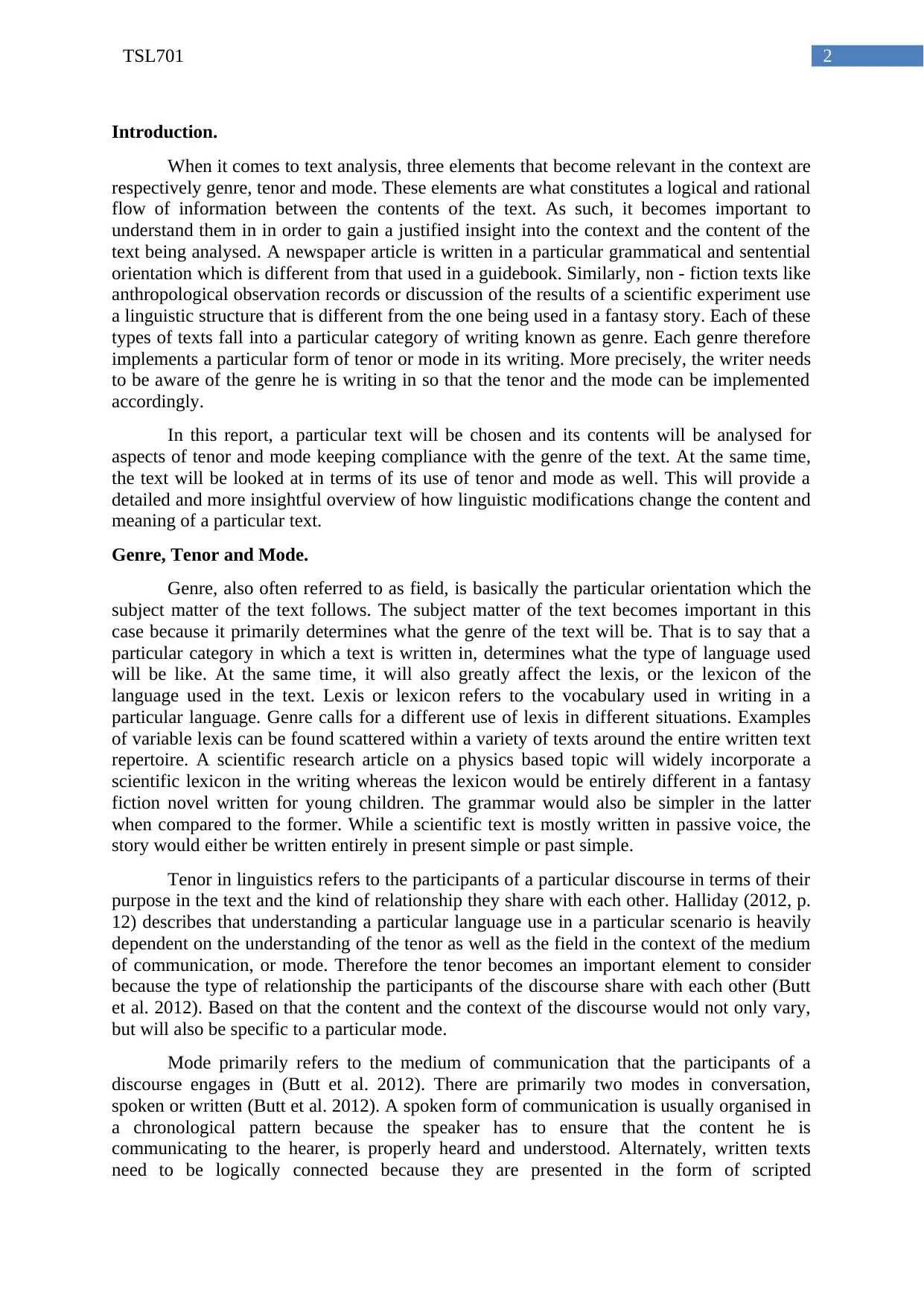
2TSL701
Introduction.
When it comes to text analysis, three elements that become relevant in the context are
respectively genre, tenor and mode. These elements are what constitutes a logical and rational
flow of information between the contents of the text. As such, it becomes important to
understand them in in order to gain a justified insight into the context and the content of the
text being analysed. A newspaper article is written in a particular grammatical and sentential
orientation which is different from that used in a guidebook. Similarly, non - fiction texts like
anthropological observation records or discussion of the results of a scientific experiment use
a linguistic structure that is different from the one being used in a fantasy story. Each of these
types of texts fall into a particular category of writing known as genre. Each genre therefore
implements a particular form of tenor or mode in its writing. More precisely, the writer needs
to be aware of the genre he is writing in so that the tenor and the mode can be implemented
accordingly.
In this report, a particular text will be chosen and its contents will be analysed for
aspects of tenor and mode keeping compliance with the genre of the text. At the same time,
the text will be looked at in terms of its use of tenor and mode as well. This will provide a
detailed and more insightful overview of how linguistic modifications change the content and
meaning of a particular text.
Genre, Tenor and Mode.
Genre, also often referred to as field, is basically the particular orientation which the
subject matter of the text follows. The subject matter of the text becomes important in this
case because it primarily determines what the genre of the text will be. That is to say that a
particular category in which a text is written in, determines what the type of language used
will be like. At the same time, it will also greatly affect the lexis, or the lexicon of the
language used in the text. Lexis or lexicon refers to the vocabulary used in writing in a
particular language. Genre calls for a different use of lexis in different situations. Examples
of variable lexis can be found scattered within a variety of texts around the entire written text
repertoire. A scientific research article on a physics based topic will widely incorporate a
scientific lexicon in the writing whereas the lexicon would be entirely different in a fantasy
fiction novel written for young children. The grammar would also be simpler in the latter
when compared to the former. While a scientific text is mostly written in passive voice, the
story would either be written entirely in present simple or past simple.
Tenor in linguistics refers to the participants of a particular discourse in terms of their
purpose in the text and the kind of relationship they share with each other. Halliday (2012, p.
12) describes that understanding a particular language use in a particular scenario is heavily
dependent on the understanding of the tenor as well as the field in the context of the medium
of communication, or mode. Therefore the tenor becomes an important element to consider
because the type of relationship the participants of the discourse share with each other (Butt
et al. 2012). Based on that the content and the context of the discourse would not only vary,
but will also be specific to a particular mode.
Mode primarily refers to the medium of communication that the participants of a
discourse engages in (Butt et al. 2012). There are primarily two modes in conversation,
spoken or written (Butt et al. 2012). A spoken form of communication is usually organised in
a chronological pattern because the speaker has to ensure that the content he is
communicating to the hearer, is properly heard and understood. Alternately, written texts
need to be logically connected because they are presented in the form of scripted
Introduction.
When it comes to text analysis, three elements that become relevant in the context are
respectively genre, tenor and mode. These elements are what constitutes a logical and rational
flow of information between the contents of the text. As such, it becomes important to
understand them in in order to gain a justified insight into the context and the content of the
text being analysed. A newspaper article is written in a particular grammatical and sentential
orientation which is different from that used in a guidebook. Similarly, non - fiction texts like
anthropological observation records or discussion of the results of a scientific experiment use
a linguistic structure that is different from the one being used in a fantasy story. Each of these
types of texts fall into a particular category of writing known as genre. Each genre therefore
implements a particular form of tenor or mode in its writing. More precisely, the writer needs
to be aware of the genre he is writing in so that the tenor and the mode can be implemented
accordingly.
In this report, a particular text will be chosen and its contents will be analysed for
aspects of tenor and mode keeping compliance with the genre of the text. At the same time,
the text will be looked at in terms of its use of tenor and mode as well. This will provide a
detailed and more insightful overview of how linguistic modifications change the content and
meaning of a particular text.
Genre, Tenor and Mode.
Genre, also often referred to as field, is basically the particular orientation which the
subject matter of the text follows. The subject matter of the text becomes important in this
case because it primarily determines what the genre of the text will be. That is to say that a
particular category in which a text is written in, determines what the type of language used
will be like. At the same time, it will also greatly affect the lexis, or the lexicon of the
language used in the text. Lexis or lexicon refers to the vocabulary used in writing in a
particular language. Genre calls for a different use of lexis in different situations. Examples
of variable lexis can be found scattered within a variety of texts around the entire written text
repertoire. A scientific research article on a physics based topic will widely incorporate a
scientific lexicon in the writing whereas the lexicon would be entirely different in a fantasy
fiction novel written for young children. The grammar would also be simpler in the latter
when compared to the former. While a scientific text is mostly written in passive voice, the
story would either be written entirely in present simple or past simple.
Tenor in linguistics refers to the participants of a particular discourse in terms of their
purpose in the text and the kind of relationship they share with each other. Halliday (2012, p.
12) describes that understanding a particular language use in a particular scenario is heavily
dependent on the understanding of the tenor as well as the field in the context of the medium
of communication, or mode. Therefore the tenor becomes an important element to consider
because the type of relationship the participants of the discourse share with each other (Butt
et al. 2012). Based on that the content and the context of the discourse would not only vary,
but will also be specific to a particular mode.
Mode primarily refers to the medium of communication that the participants of a
discourse engages in (Butt et al. 2012). There are primarily two modes in conversation,
spoken or written (Butt et al. 2012). A spoken form of communication is usually organised in
a chronological pattern because the speaker has to ensure that the content he is
communicating to the hearer, is properly heard and understood. Alternately, written texts
need to be logically connected because they are presented in the form of scripted
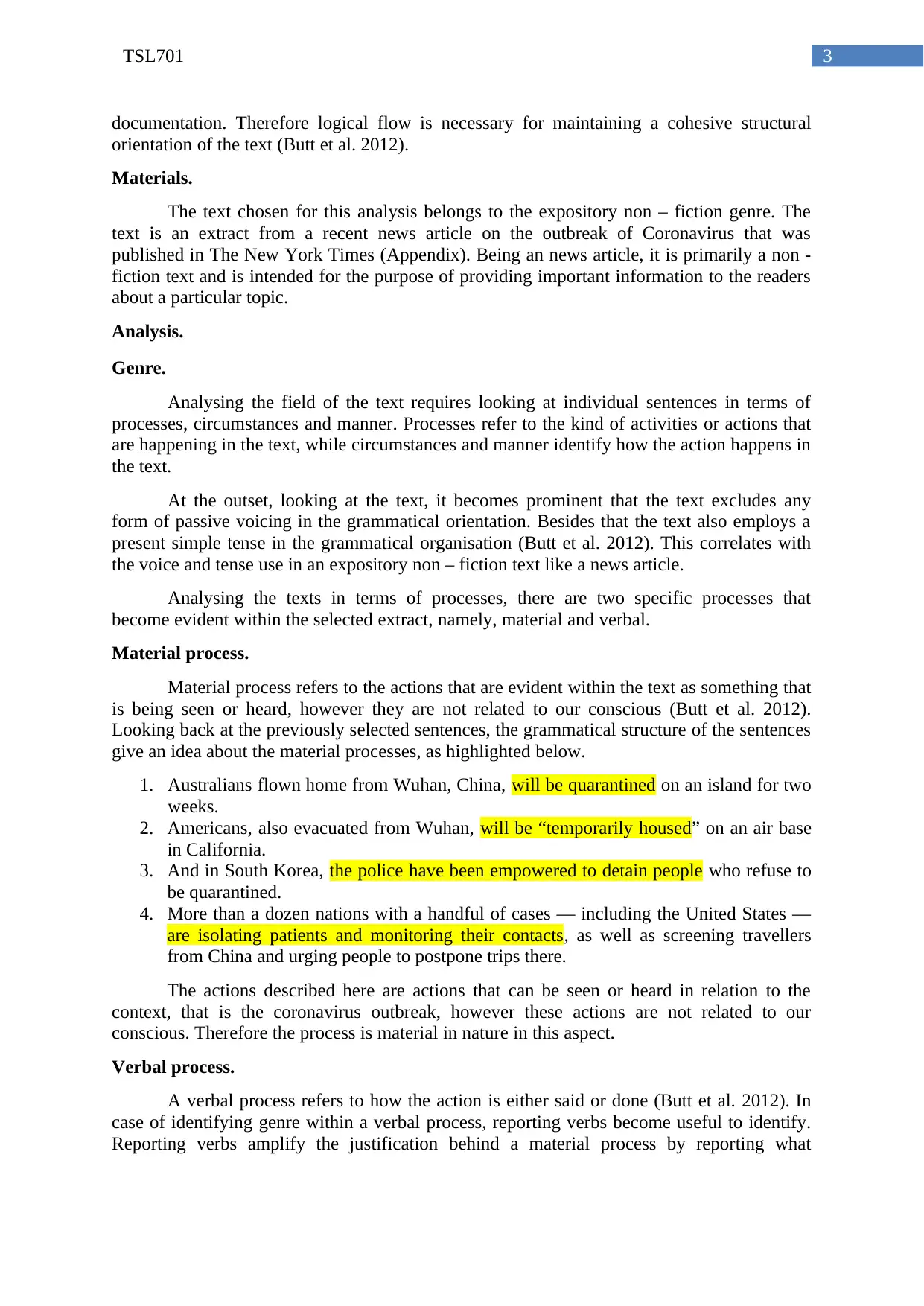
3TSL701
documentation. Therefore logical flow is necessary for maintaining a cohesive structural
orientation of the text (Butt et al. 2012).
Materials.
The text chosen for this analysis belongs to the expository non – fiction genre. The
text is an extract from a recent news article on the outbreak of Coronavirus that was
published in The New York Times (Appendix). Being an news article, it is primarily a non -
fiction text and is intended for the purpose of providing important information to the readers
about a particular topic.
Analysis.
Genre.
Analysing the field of the text requires looking at individual sentences in terms of
processes, circumstances and manner. Processes refer to the kind of activities or actions that
are happening in the text, while circumstances and manner identify how the action happens in
the text.
At the outset, looking at the text, it becomes prominent that the text excludes any
form of passive voicing in the grammatical orientation. Besides that the text also employs a
present simple tense in the grammatical organisation (Butt et al. 2012). This correlates with
the voice and tense use in an expository non – fiction text like a news article.
Analysing the texts in terms of processes, there are two specific processes that
become evident within the selected extract, namely, material and verbal.
Material process.
Material process refers to the actions that are evident within the text as something that
is being seen or heard, however they are not related to our conscious (Butt et al. 2012).
Looking back at the previously selected sentences, the grammatical structure of the sentences
give an idea about the material processes, as highlighted below.
1. Australians flown home from Wuhan, China, will be quarantined on an island for two
weeks.
2. Americans, also evacuated from Wuhan, will be “temporarily housed” on an air base
in California.
3. And in South Korea, the police have been empowered to detain people who refuse to
be quarantined.
4. More than a dozen nations with a handful of cases — including the United States —
are isolating patients and monitoring their contacts, as well as screening travellers
from China and urging people to postpone trips there.
The actions described here are actions that can be seen or heard in relation to the
context, that is the coronavirus outbreak, however these actions are not related to our
conscious. Therefore the process is material in nature in this aspect.
Verbal process.
A verbal process refers to how the action is either said or done (Butt et al. 2012). In
case of identifying genre within a verbal process, reporting verbs become useful to identify.
Reporting verbs amplify the justification behind a material process by reporting what
documentation. Therefore logical flow is necessary for maintaining a cohesive structural
orientation of the text (Butt et al. 2012).
Materials.
The text chosen for this analysis belongs to the expository non – fiction genre. The
text is an extract from a recent news article on the outbreak of Coronavirus that was
published in The New York Times (Appendix). Being an news article, it is primarily a non -
fiction text and is intended for the purpose of providing important information to the readers
about a particular topic.
Analysis.
Genre.
Analysing the field of the text requires looking at individual sentences in terms of
processes, circumstances and manner. Processes refer to the kind of activities or actions that
are happening in the text, while circumstances and manner identify how the action happens in
the text.
At the outset, looking at the text, it becomes prominent that the text excludes any
form of passive voicing in the grammatical orientation. Besides that the text also employs a
present simple tense in the grammatical organisation (Butt et al. 2012). This correlates with
the voice and tense use in an expository non – fiction text like a news article.
Analysing the texts in terms of processes, there are two specific processes that
become evident within the selected extract, namely, material and verbal.
Material process.
Material process refers to the actions that are evident within the text as something that
is being seen or heard, however they are not related to our conscious (Butt et al. 2012).
Looking back at the previously selected sentences, the grammatical structure of the sentences
give an idea about the material processes, as highlighted below.
1. Australians flown home from Wuhan, China, will be quarantined on an island for two
weeks.
2. Americans, also evacuated from Wuhan, will be “temporarily housed” on an air base
in California.
3. And in South Korea, the police have been empowered to detain people who refuse to
be quarantined.
4. More than a dozen nations with a handful of cases — including the United States —
are isolating patients and monitoring their contacts, as well as screening travellers
from China and urging people to postpone trips there.
The actions described here are actions that can be seen or heard in relation to the
context, that is the coronavirus outbreak, however these actions are not related to our
conscious. Therefore the process is material in nature in this aspect.
Verbal process.
A verbal process refers to how the action is either said or done (Butt et al. 2012). In
case of identifying genre within a verbal process, reporting verbs become useful to identify.
Reporting verbs amplify the justification behind a material process by reporting what
Secure Best Marks with AI Grader
Need help grading? Try our AI Grader for instant feedback on your assignments.
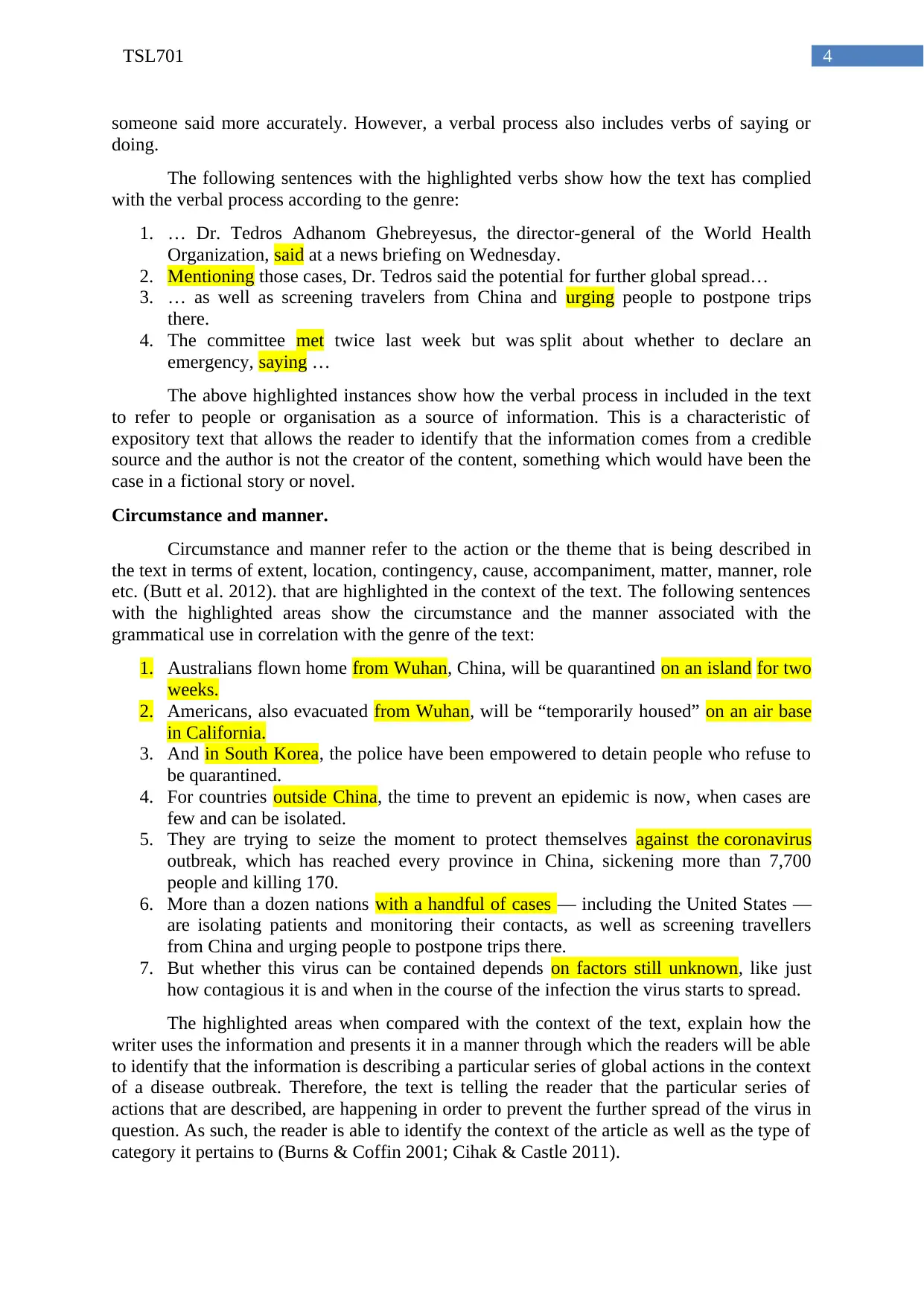
4TSL701
someone said more accurately. However, a verbal process also includes verbs of saying or
doing.
The following sentences with the highlighted verbs show how the text has complied
with the verbal process according to the genre:
1. … Dr. Tedros Adhanom Ghebreyesus, the director-general of the World Health
Organization, said at a news briefing on Wednesday.
2. Mentioning those cases, Dr. Tedros said the potential for further global spread…
3. … as well as screening travelers from China and urging people to postpone trips
there.
4. The committee met twice last week but was split about whether to declare an
emergency, saying …
The above highlighted instances show how the verbal process in included in the text
to refer to people or organisation as a source of information. This is a characteristic of
expository text that allows the reader to identify that the information comes from a credible
source and the author is not the creator of the content, something which would have been the
case in a fictional story or novel.
Circumstance and manner.
Circumstance and manner refer to the action or the theme that is being described in
the text in terms of extent, location, contingency, cause, accompaniment, matter, manner, role
etc. (Butt et al. 2012). that are highlighted in the context of the text. The following sentences
with the highlighted areas show the circumstance and the manner associated with the
grammatical use in correlation with the genre of the text:
1. Australians flown home from Wuhan, China, will be quarantined on an island for two
weeks.
2. Americans, also evacuated from Wuhan, will be “temporarily housed” on an air base
in California.
3. And in South Korea, the police have been empowered to detain people who refuse to
be quarantined.
4. For countries outside China, the time to prevent an epidemic is now, when cases are
few and can be isolated.
5. They are trying to seize the moment to protect themselves against the coronavirus
outbreak, which has reached every province in China, sickening more than 7,700
people and killing 170.
6. More than a dozen nations with a handful of cases — including the United States —
are isolating patients and monitoring their contacts, as well as screening travellers
from China and urging people to postpone trips there.
7. But whether this virus can be contained depends on factors still unknown, like just
how contagious it is and when in the course of the infection the virus starts to spread.
The highlighted areas when compared with the context of the text, explain how the
writer uses the information and presents it in a manner through which the readers will be able
to identify that the information is describing a particular series of global actions in the context
of a disease outbreak. Therefore, the text is telling the reader that the particular series of
actions that are described, are happening in order to prevent the further spread of the virus in
question. As such, the reader is able to identify the context of the article as well as the type of
category it pertains to (Burns & Coffin 2001; Cihak & Castle 2011).
someone said more accurately. However, a verbal process also includes verbs of saying or
doing.
The following sentences with the highlighted verbs show how the text has complied
with the verbal process according to the genre:
1. … Dr. Tedros Adhanom Ghebreyesus, the director-general of the World Health
Organization, said at a news briefing on Wednesday.
2. Mentioning those cases, Dr. Tedros said the potential for further global spread…
3. … as well as screening travelers from China and urging people to postpone trips
there.
4. The committee met twice last week but was split about whether to declare an
emergency, saying …
The above highlighted instances show how the verbal process in included in the text
to refer to people or organisation as a source of information. This is a characteristic of
expository text that allows the reader to identify that the information comes from a credible
source and the author is not the creator of the content, something which would have been the
case in a fictional story or novel.
Circumstance and manner.
Circumstance and manner refer to the action or the theme that is being described in
the text in terms of extent, location, contingency, cause, accompaniment, matter, manner, role
etc. (Butt et al. 2012). that are highlighted in the context of the text. The following sentences
with the highlighted areas show the circumstance and the manner associated with the
grammatical use in correlation with the genre of the text:
1. Australians flown home from Wuhan, China, will be quarantined on an island for two
weeks.
2. Americans, also evacuated from Wuhan, will be “temporarily housed” on an air base
in California.
3. And in South Korea, the police have been empowered to detain people who refuse to
be quarantined.
4. For countries outside China, the time to prevent an epidemic is now, when cases are
few and can be isolated.
5. They are trying to seize the moment to protect themselves against the coronavirus
outbreak, which has reached every province in China, sickening more than 7,700
people and killing 170.
6. More than a dozen nations with a handful of cases — including the United States —
are isolating patients and monitoring their contacts, as well as screening travellers
from China and urging people to postpone trips there.
7. But whether this virus can be contained depends on factors still unknown, like just
how contagious it is and when in the course of the infection the virus starts to spread.
The highlighted areas when compared with the context of the text, explain how the
writer uses the information and presents it in a manner through which the readers will be able
to identify that the information is describing a particular series of global actions in the context
of a disease outbreak. Therefore, the text is telling the reader that the particular series of
actions that are described, are happening in order to prevent the further spread of the virus in
question. As such, the reader is able to identify the context of the article as well as the type of
category it pertains to (Burns & Coffin 2001; Cihak & Castle 2011).
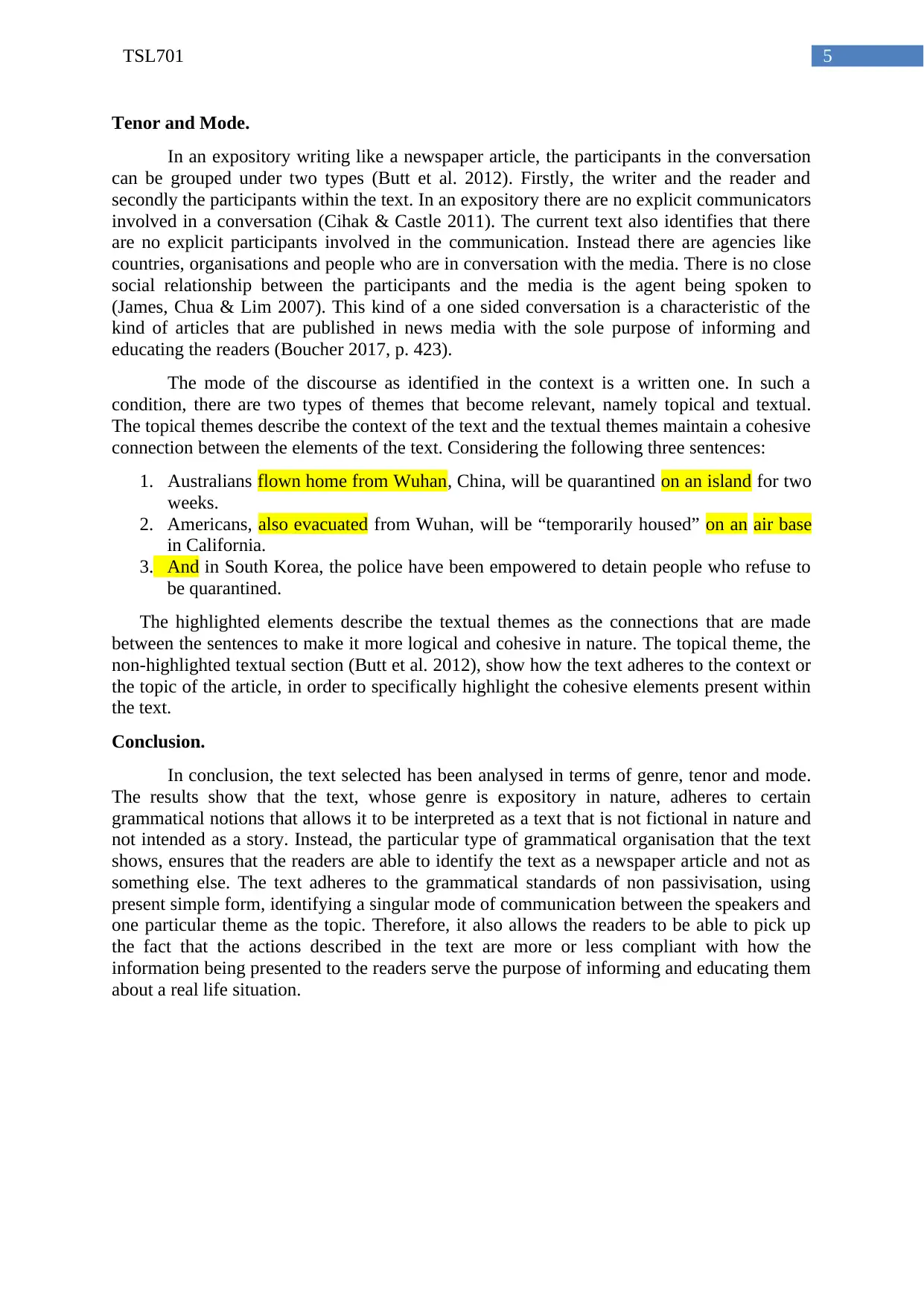
5TSL701
Tenor and Mode.
In an expository writing like a newspaper article, the participants in the conversation
can be grouped under two types (Butt et al. 2012). Firstly, the writer and the reader and
secondly the participants within the text. In an expository there are no explicit communicators
involved in a conversation (Cihak & Castle 2011). The current text also identifies that there
are no explicit participants involved in the communication. Instead there are agencies like
countries, organisations and people who are in conversation with the media. There is no close
social relationship between the participants and the media is the agent being spoken to
(James, Chua & Lim 2007). This kind of a one sided conversation is a characteristic of the
kind of articles that are published in news media with the sole purpose of informing and
educating the readers (Boucher 2017, p. 423).
The mode of the discourse as identified in the context is a written one. In such a
condition, there are two types of themes that become relevant, namely topical and textual.
The topical themes describe the context of the text and the textual themes maintain a cohesive
connection between the elements of the text. Considering the following three sentences:
1. Australians flown home from Wuhan, China, will be quarantined on an island for two
weeks.
2. Americans, also evacuated from Wuhan, will be “temporarily housed” on an air base
in California.
3. And in South Korea, the police have been empowered to detain people who refuse to
be quarantined.
The highlighted elements describe the textual themes as the connections that are made
between the sentences to make it more logical and cohesive in nature. The topical theme, the
non-highlighted textual section (Butt et al. 2012), show how the text adheres to the context or
the topic of the article, in order to specifically highlight the cohesive elements present within
the text.
Conclusion.
In conclusion, the text selected has been analysed in terms of genre, tenor and mode.
The results show that the text, whose genre is expository in nature, adheres to certain
grammatical notions that allows it to be interpreted as a text that is not fictional in nature and
not intended as a story. Instead, the particular type of grammatical organisation that the text
shows, ensures that the readers are able to identify the text as a newspaper article and not as
something else. The text adheres to the grammatical standards of non passivisation, using
present simple form, identifying a singular mode of communication between the speakers and
one particular theme as the topic. Therefore, it also allows the readers to be able to pick up
the fact that the actions described in the text are more or less compliant with how the
information being presented to the readers serve the purpose of informing and educating them
about a real life situation.
Tenor and Mode.
In an expository writing like a newspaper article, the participants in the conversation
can be grouped under two types (Butt et al. 2012). Firstly, the writer and the reader and
secondly the participants within the text. In an expository there are no explicit communicators
involved in a conversation (Cihak & Castle 2011). The current text also identifies that there
are no explicit participants involved in the communication. Instead there are agencies like
countries, organisations and people who are in conversation with the media. There is no close
social relationship between the participants and the media is the agent being spoken to
(James, Chua & Lim 2007). This kind of a one sided conversation is a characteristic of the
kind of articles that are published in news media with the sole purpose of informing and
educating the readers (Boucher 2017, p. 423).
The mode of the discourse as identified in the context is a written one. In such a
condition, there are two types of themes that become relevant, namely topical and textual.
The topical themes describe the context of the text and the textual themes maintain a cohesive
connection between the elements of the text. Considering the following three sentences:
1. Australians flown home from Wuhan, China, will be quarantined on an island for two
weeks.
2. Americans, also evacuated from Wuhan, will be “temporarily housed” on an air base
in California.
3. And in South Korea, the police have been empowered to detain people who refuse to
be quarantined.
The highlighted elements describe the textual themes as the connections that are made
between the sentences to make it more logical and cohesive in nature. The topical theme, the
non-highlighted textual section (Butt et al. 2012), show how the text adheres to the context or
the topic of the article, in order to specifically highlight the cohesive elements present within
the text.
Conclusion.
In conclusion, the text selected has been analysed in terms of genre, tenor and mode.
The results show that the text, whose genre is expository in nature, adheres to certain
grammatical notions that allows it to be interpreted as a text that is not fictional in nature and
not intended as a story. Instead, the particular type of grammatical organisation that the text
shows, ensures that the readers are able to identify the text as a newspaper article and not as
something else. The text adheres to the grammatical standards of non passivisation, using
present simple form, identifying a singular mode of communication between the speakers and
one particular theme as the topic. Therefore, it also allows the readers to be able to pick up
the fact that the actions described in the text are more or less compliant with how the
information being presented to the readers serve the purpose of informing and educating them
about a real life situation.
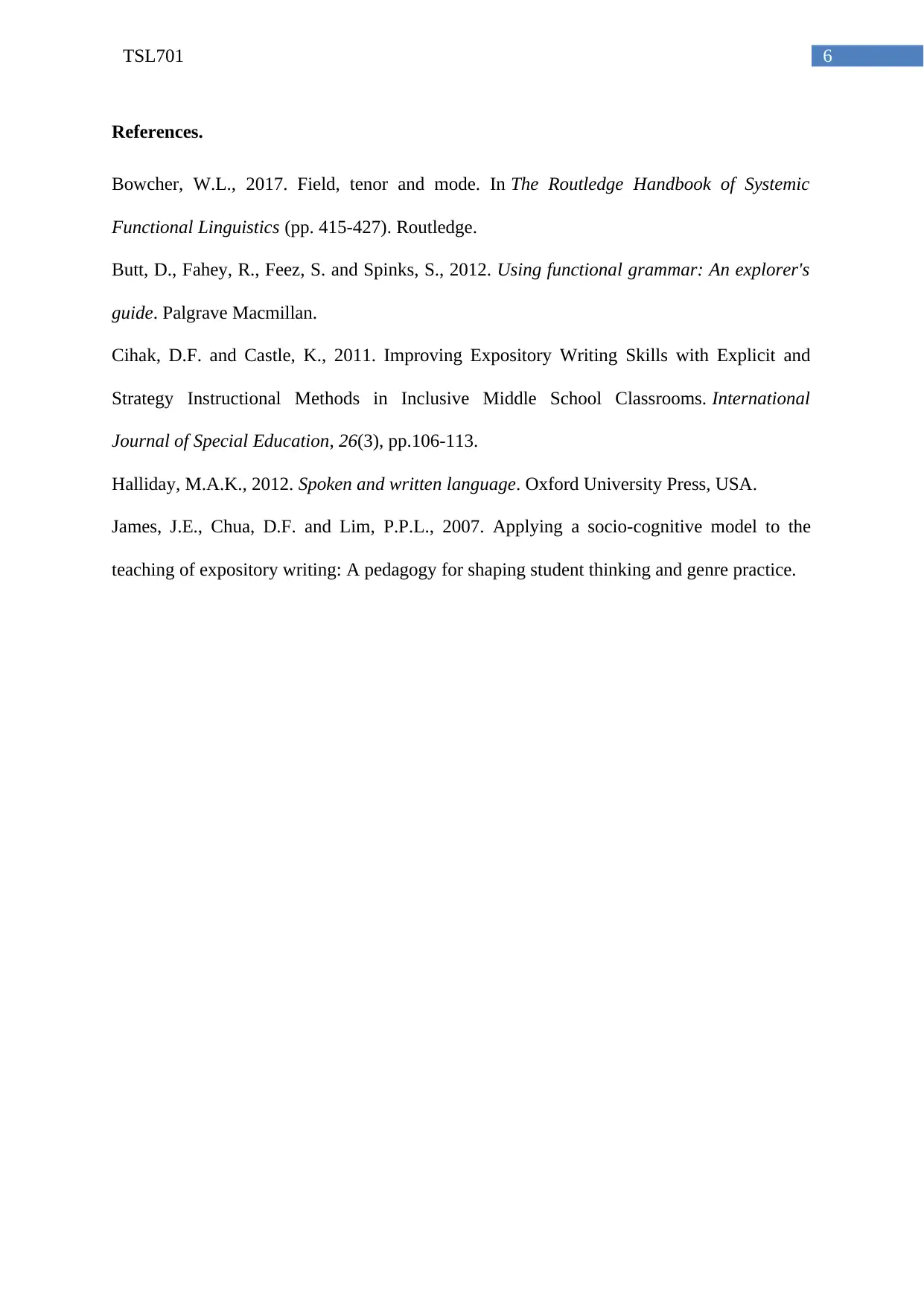
6TSL701
References.
Bowcher, W.L., 2017. Field, tenor and mode. In The Routledge Handbook of Systemic
Functional Linguistics (pp. 415-427). Routledge.
Butt, D., Fahey, R., Feez, S. and Spinks, S., 2012. Using functional grammar: An explorer's
guide. Palgrave Macmillan.
Cihak, D.F. and Castle, K., 2011. Improving Expository Writing Skills with Explicit and
Strategy Instructional Methods in Inclusive Middle School Classrooms. International
Journal of Special Education, 26(3), pp.106-113.
Halliday, M.A.K., 2012. Spoken and written language. Oxford University Press, USA.
James, J.E., Chua, D.F. and Lim, P.P.L., 2007. Applying a socio-cognitive model to the
teaching of expository writing: A pedagogy for shaping student thinking and genre practice.
References.
Bowcher, W.L., 2017. Field, tenor and mode. In The Routledge Handbook of Systemic
Functional Linguistics (pp. 415-427). Routledge.
Butt, D., Fahey, R., Feez, S. and Spinks, S., 2012. Using functional grammar: An explorer's
guide. Palgrave Macmillan.
Cihak, D.F. and Castle, K., 2011. Improving Expository Writing Skills with Explicit and
Strategy Instructional Methods in Inclusive Middle School Classrooms. International
Journal of Special Education, 26(3), pp.106-113.
Halliday, M.A.K., 2012. Spoken and written language. Oxford University Press, USA.
James, J.E., Chua, D.F. and Lim, P.P.L., 2007. Applying a socio-cognitive model to the
teaching of expository writing: A pedagogy for shaping student thinking and genre practice.
Paraphrase This Document
Need a fresh take? Get an instant paraphrase of this document with our AI Paraphraser
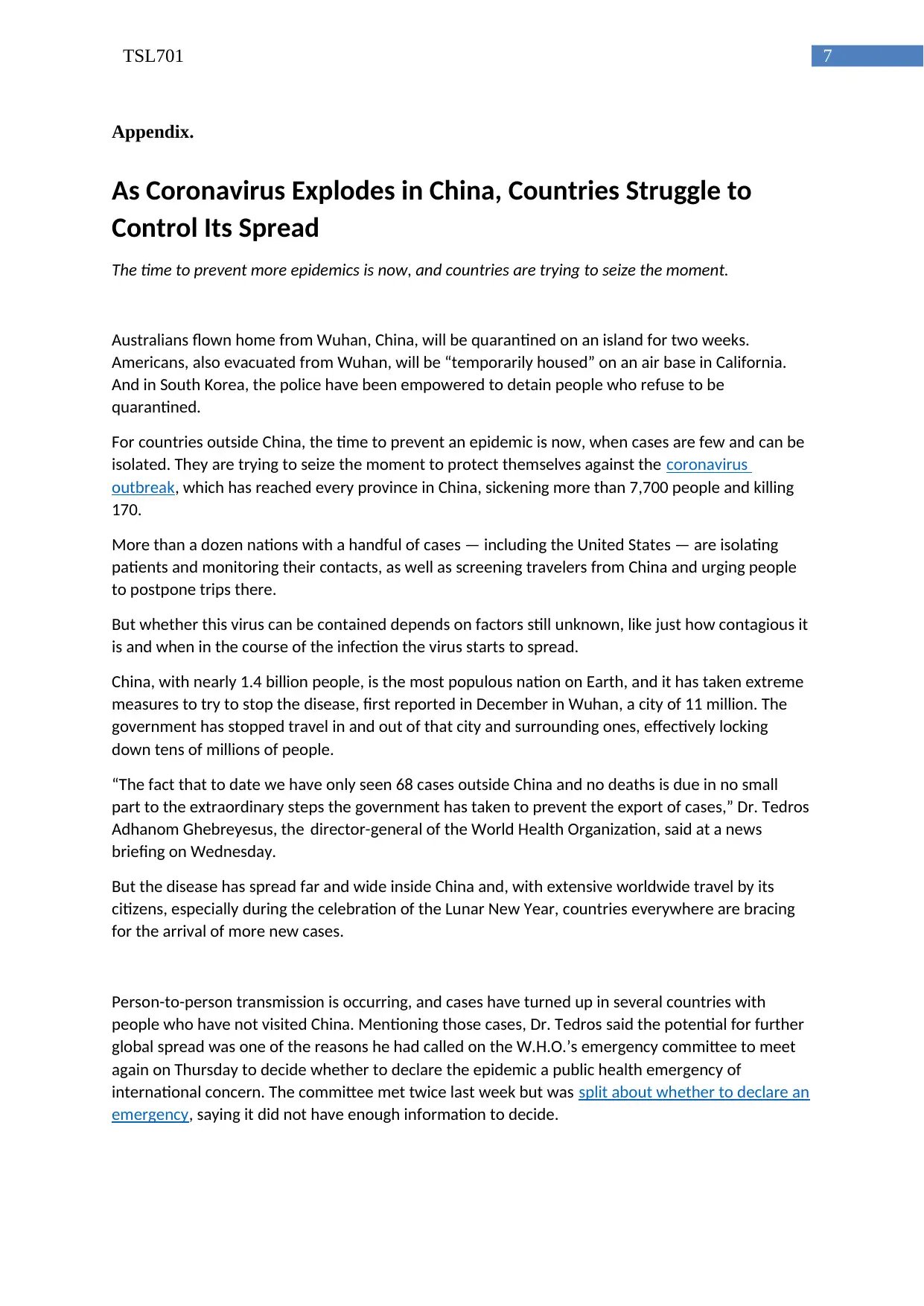
7TSL701
Appendix.
As Coronavirus Explodes in China, Countries Struggle to
Control Its Spread
The time to prevent more epidemics is now, and countries are trying to seize the moment.
Australians flown home from Wuhan, China, will be quarantined on an island for two weeks.
Americans, also evacuated from Wuhan, will be “temporarily housed” on an air base in California.
And in South Korea, the police have been empowered to detain people who refuse to be
quarantined.
For countries outside China, the time to prevent an epidemic is now, when cases are few and can be
isolated. They are trying to seize the moment to protect themselves against the coronavirus
outbreak, which has reached every province in China, sickening more than 7,700 people and killing
170.
More than a dozen nations with a handful of cases — including the United States — are isolating
patients and monitoring their contacts, as well as screening travelers from China and urging people
to postpone trips there.
But whether this virus can be contained depends on factors still unknown, like just how contagious it
is and when in the course of the infection the virus starts to spread.
China, with nearly 1.4 billion people, is the most populous nation on Earth, and it has taken extreme
measures to try to stop the disease, first reported in December in Wuhan, a city of 11 million. The
government has stopped travel in and out of that city and surrounding ones, effectively locking
down tens of millions of people.
“The fact that to date we have only seen 68 cases outside China and no deaths is due in no small
part to the extraordinary steps the government has taken to prevent the export of cases,” Dr. Tedros
Adhanom Ghebreyesus, the director-general of the World Health Organization, said at a news
briefing on Wednesday.
But the disease has spread far and wide inside China and, with extensive worldwide travel by its
citizens, especially during the celebration of the Lunar New Year, countries everywhere are bracing
for the arrival of more new cases.
Person-to-person transmission is occurring, and cases have turned up in several countries with
people who have not visited China. Mentioning those cases, Dr. Tedros said the potential for further
global spread was one of the reasons he had called on the W.H.O.’s emergency committee to meet
again on Thursday to decide whether to declare the epidemic a public health emergency of
international concern. The committee met twice last week but was split about whether to declare an
emergency, saying it did not have enough information to decide.
Appendix.
As Coronavirus Explodes in China, Countries Struggle to
Control Its Spread
The time to prevent more epidemics is now, and countries are trying to seize the moment.
Australians flown home from Wuhan, China, will be quarantined on an island for two weeks.
Americans, also evacuated from Wuhan, will be “temporarily housed” on an air base in California.
And in South Korea, the police have been empowered to detain people who refuse to be
quarantined.
For countries outside China, the time to prevent an epidemic is now, when cases are few and can be
isolated. They are trying to seize the moment to protect themselves against the coronavirus
outbreak, which has reached every province in China, sickening more than 7,700 people and killing
170.
More than a dozen nations with a handful of cases — including the United States — are isolating
patients and monitoring their contacts, as well as screening travelers from China and urging people
to postpone trips there.
But whether this virus can be contained depends on factors still unknown, like just how contagious it
is and when in the course of the infection the virus starts to spread.
China, with nearly 1.4 billion people, is the most populous nation on Earth, and it has taken extreme
measures to try to stop the disease, first reported in December in Wuhan, a city of 11 million. The
government has stopped travel in and out of that city and surrounding ones, effectively locking
down tens of millions of people.
“The fact that to date we have only seen 68 cases outside China and no deaths is due in no small
part to the extraordinary steps the government has taken to prevent the export of cases,” Dr. Tedros
Adhanom Ghebreyesus, the director-general of the World Health Organization, said at a news
briefing on Wednesday.
But the disease has spread far and wide inside China and, with extensive worldwide travel by its
citizens, especially during the celebration of the Lunar New Year, countries everywhere are bracing
for the arrival of more new cases.
Person-to-person transmission is occurring, and cases have turned up in several countries with
people who have not visited China. Mentioning those cases, Dr. Tedros said the potential for further
global spread was one of the reasons he had called on the W.H.O.’s emergency committee to meet
again on Thursday to decide whether to declare the epidemic a public health emergency of
international concern. The committee met twice last week but was split about whether to declare an
emergency, saying it did not have enough information to decide.
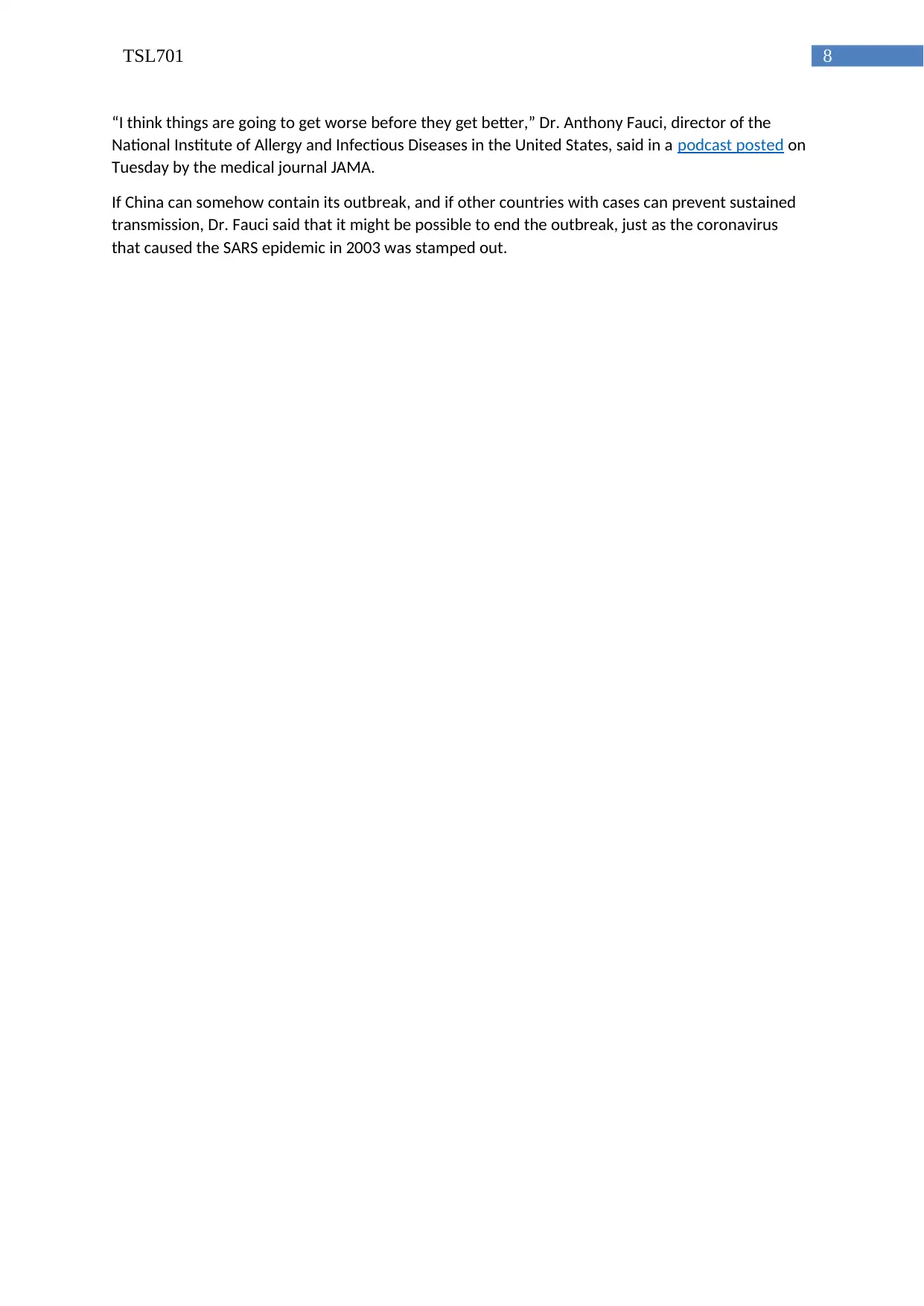
8TSL701
“I think things are going to get worse before they get better,” Dr. Anthony Fauci, director of the
National Institute of Allergy and Infectious Diseases in the United States, said in a podcast posted on
Tuesday by the medical journal JAMA.
If China can somehow contain its outbreak, and if other countries with cases can prevent sustained
transmission, Dr. Fauci said that it might be possible to end the outbreak, just as the coronavirus
that caused the SARS epidemic in 2003 was stamped out.
“I think things are going to get worse before they get better,” Dr. Anthony Fauci, director of the
National Institute of Allergy and Infectious Diseases in the United States, said in a podcast posted on
Tuesday by the medical journal JAMA.
If China can somehow contain its outbreak, and if other countries with cases can prevent sustained
transmission, Dr. Fauci said that it might be possible to end the outbreak, just as the coronavirus
that caused the SARS epidemic in 2003 was stamped out.
1 out of 9
Your All-in-One AI-Powered Toolkit for Academic Success.
+13062052269
info@desklib.com
Available 24*7 on WhatsApp / Email
![[object Object]](/_next/static/media/star-bottom.7253800d.svg)
Unlock your academic potential
© 2024 | Zucol Services PVT LTD | All rights reserved.

